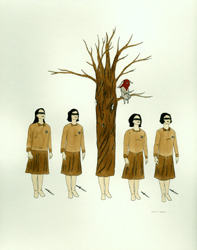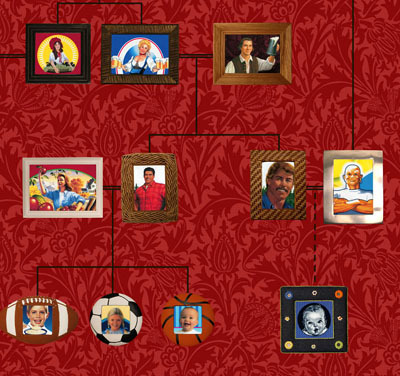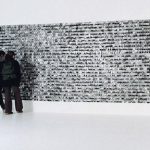Special Features: Nina Katchadourian on Teaching
For this Special Feature, NYFA Current asked New York-based artist Nina Katchadourian to write on her first “New York, New York” class, for which she leads a group of students through what she calls “the cold, deadly river of contemporary art.” Katchadourian was a NYFA Artists’ Fellowship winner in the category of Video in 2004.
Nina Katchadourian. Genealogy of the Supermarket (detail) (2005). Installation view. Courtesy the artist and Sara Meltzer Gallery, New York.
I’m teaching a class right now called “New York, New York” which involves taking a group of 12 students from a well-known New England art school to look at art in New York City. We come to New York every other week and cram in as many gallery visits, artist’s talks, and relevant museum shows as possible. In between our field trips, we meet in a classroom to discuss what we’ve seen and the written reviews that three students each week are responsible for generating, based on the shows we saw the week before. The group is mostly undergrads, with a few grads thrown in as well. Unlike some field trip situations I’ve had with students—where they follow ten paces behind me and make me feel like some creepy Pied Piper leading them into the cold, deadly river of contemporary art—this group isn’t scared of me and they’re talkative and forthcoming with their opinions. I thought I’d pick out a few highlights and telling moments from our first day together in the city.
Even from the sidewalk on 22nd Street, just outside Sonnabend Gallery, we could hear the beckoning call of the piece in the front room, King (A Portrait of Michael Jackson), a multi-channel “video portrait” by Candice Breitz where 16 Michael Jackson devotees re-perform the Thriller album from beginning to end. Each of these Jacko fans has a sound feed of the album in their ear to sing along with (but we hear only their singing) and occupies one vertically-oriented plasma TV screen; together, this line-up forms a “diverse chorus of amateurs,” as one of my students put it, “in which these people are part of a safety-in-numbers net.” The sound is nicely balanced so that you can’t pick out any one person in particular, although the most zealous of the bunch take the initiative to add MJ’s iconic “ooo!” outbursts. A few also sing along with musical flourishes. Queen (A Portrait of Madonna) does the same treatment with Madonna: 30 fans sing Immaculate Collection from start to finish.
The class was utterly sucked in. I asked how they felt towards the fans. One person said he found them completely pathetic, a group of absolutely maladjusted freaks with no life. Another confessed that this kind of singing and dancing is exactly what she does at home. In one paper, a student argued that “television is so accepted and so much part of us as a culture that we are almost able to lose the screen and the context and see only the information: in some ways it is purer information than most people can distill from literature or art.” Long note in the margin from me in response to that sentence, but I thought a lot about the conflation of “television” and “video” and the way a monitor in a gallery with an image on it and a news image on a television screen seemed to be interchangeable to this student.

Marcel Dzama. Untitled (2005). Ink and watercolor on paper. Courtesy the artist and David Zwirner, New York.
Partially in order to provide a counterpoint to the dazzling production values of Breitz’s show, we moved on to John Pylypchuk’s show at Friedrich Petzel Gallery and to Marcel Dzama’s at David Zwirner Gallery. There wasn’t much of a reaction to either one, which surprised me. I thought they’d go for Pylypchuk’s mean-spirited, fucked up stuffed animals aesthetic. I think I was the only one that found the show quite funny, and I felt like the immature one in the group since I cackled quite a bit at some of the abject cats and bratty titles. Dzama’s show was elegant and alluring, as always, but I realized that I need a few years away from Dzama at this point if I’m going to appreciate his work again. I did like the large-format drawings and the way they opened up new possibilities for miniature narratives within the image as a whole. But overall, the lovely palette and now-familiar brand of uncanniness starts a low droning sound in my head that transforms me into a very woozy, lazy viewer. I just couldn’t snap out of it.
Later in the day, we headed up to the Whitney for the Smithson show, which the class quite uniformly gave a thumbs down. According to one student, “The show as a whole had a pathetic quality that I couldn’t get past. It seemed desperately cobbled together somehow. Part of that sadness may come from a sense that we are looking into a ghostly sketchbook more than a fully realized body of work. I think his work defies being forced together into a show like this.” On one level, I agreed. It’s kind of a dry show. But it also pained me to see students bored there. I even felt a generation gap of sorts; although I’m much closer in age to these students than to Smithson, I felt like they weren’t giving this elder the props he’s due. I felt compelled to defend him, to separate the quality of the ideas and the larger project at hand from their presentation. I spent a lot of my time with Hotel Palenque, a slideshow with audio where Smithson speaks about a ruined hotel in Mexico and, for me, the piece that so clearly demonstrates his thought process. It almost seems like a key that unlocks the past-future dialectic he so often wrote about, such a clear example of how “the future is lost somewhere in the dumps of the nonhistorical past.” I’m not sure anyone else was buying it. One skeptic in the class grumbled that he hated that piece and that Smithson “sounded like he was making shit up.” I felt a bit depressed.

Robert Smithson. Floating Island to Travel Around Manhattan Island (1970/2005). Produced by Minetta Brook in collaboration with the Whitney Museum of American Art. On view September 17-25, 2005. (Photo: John Bartelstone). Courtesy Estate of Robert Smithson. Liscensed BY VAGA, New York, NY.
I wasn’t giving up yet. By the end of the Whitney debacle it was late afternoon, and we headed back downtown to the West Side and walked out onto the Charles Street pier to see if we could catch Smithson’s Floating Island, a realization of a project he proposed in 1970 that never moved beyond the diagramming stages. Our timing was perfect: at the end of the pier, bathed in the late afternoon light, a pudgy tugboat struggled furiously to pull the “island” just 100 feet off the pier. The “island” was a barge with rusted metal sides, filled with a carefully landscaped, charming little park of sorts on the inside. I was struck by how friendly the piece was in material terms; most of Smithson’s work looks so jagged and sharp that you’d likely cut yourself on it if you get too close. Floating Island looked like a great place to take a nap. It was exactly the right time to wind down the day, an optimistic closing moment where New York and art came together harmoniously, grandly, and with loads of charisma. Finally, Smithson gets some cred from the youngsters: “The sight of a little tottering tugboat-driven park steaming by into the sunset humanizes Smithson’s ideas in a way that I think was always there, but never had a proper venue or chance to express itself,” wrote one student. “I am confident after seeing the retrospective and Floating Island that Smithson’s greatest work was still ahead of him.”
Nina Katchadourian is a conceptual artist who lives in Brooklyn and spends part of each year in Finland. Her practice involves sculpture, photography, video, and sound. She is represented by Sara Meltzer Gallery in New York and Catharine Clark Gallery in San Francisco. In summer 2006, she will open a retrospective at the Tang Museum in Saratoga Springs, NY.





